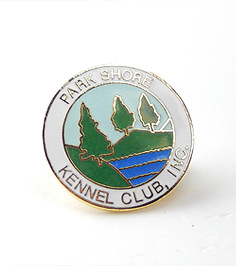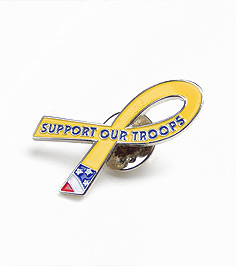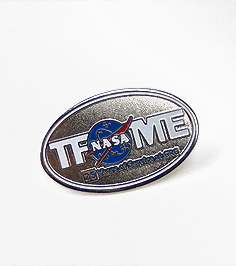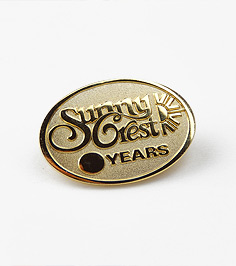
Semi-cloisonné also called Synthetic enamel, Eploa, Imitation enamel. It is a modern substitute for hard enamel.
The process is similar to cloisonné ( Hard Enamel ) except that a special liquid epoxy material is utilized to provide colors instead of the cloisonné color. Colors can be matched to Pantone Colors (PMS) in imitation enamel.
Imitation enamel replaced the cloisonné, because of similarity to hard enamel material, but shinier, lower cost, fast delivery time and much more colors to choose from.
Imitation enamel surface is flat and smooth, Basically it feels in the same level with your fingers slightly raised with logo or text, and color design ,and this emblem of the rough feeling of baking significantly different from soft enamel.

Soft enamel is another commonly substitute for the hard enamel and synthetic enamel. It differs in the color technique.
The colors are not completely filled in the recessed areas and the metal borders are much more visible. It fired at low heat to seal the colors and provide a lustrous appearance.
Both soft enamel and hard enamel are manufactured using the same procedure, but there is a slight variation in the drying process of the applied paint. Once the paint is applied, instead of subjecting it to intense pressure and temperature (as done for the manufacture of hard enamel pins), these pins are simply air-dried. A current of air is allowed to fall into the wet paint and hence the paint will dry! This is the functional difference between soft enamel pins and hard enamel pins,The difference does not end merely with the drying process.

Offset printing is the workhorse of printing. Almost every commercial printer does it. But the quality of the final product is often due to the guidance, expertise and equipment provided by the printer.
Principle of process: ink and water don't mix. Images (words and art) are put on plates, which are dampened first by water, then ink. The ink adheres to the image area, the water to the non-image area. Then the image is transferred to a rubber blanket, and from the rubber blanket to paper. That's why the process is called "offset" -- the image does not go directly to the paper from the plates, as it does in gravure printing.

Etching is a "chemical " process. It is also known as Photo Chemical Machining (PCM) and Photo Chemical Milling.
The material is dissolved when immersed in a chemical solution. It is an exceptional manufacturing process that produces the most intricate, burr free, stress free, high precision profiles in a wide range of metals. One advantage of this procedure is that it makes the resulting product very difficult to reproduce.
Additionally, photo etching makes both the product and its design more flexible. Usually , we use 0.3mm to 0.8mm thickness brass or stainless steel 430 to be etched for design.

It is a process that Die Struck into the brass to form a design.
Die struck (or Stamping) includes a variety of sheet-metal forming manufacturing processes, such as punching using a machine press or stamping press, blanking, embossing, bending, flanging, and coining. This could be a single stage operation where every stroke of the press produce the desired form on the sheet metal part, or could occur through a series of stages. The process is usually carried out on sheet metal.
Usually, we offer brass , iron etc.